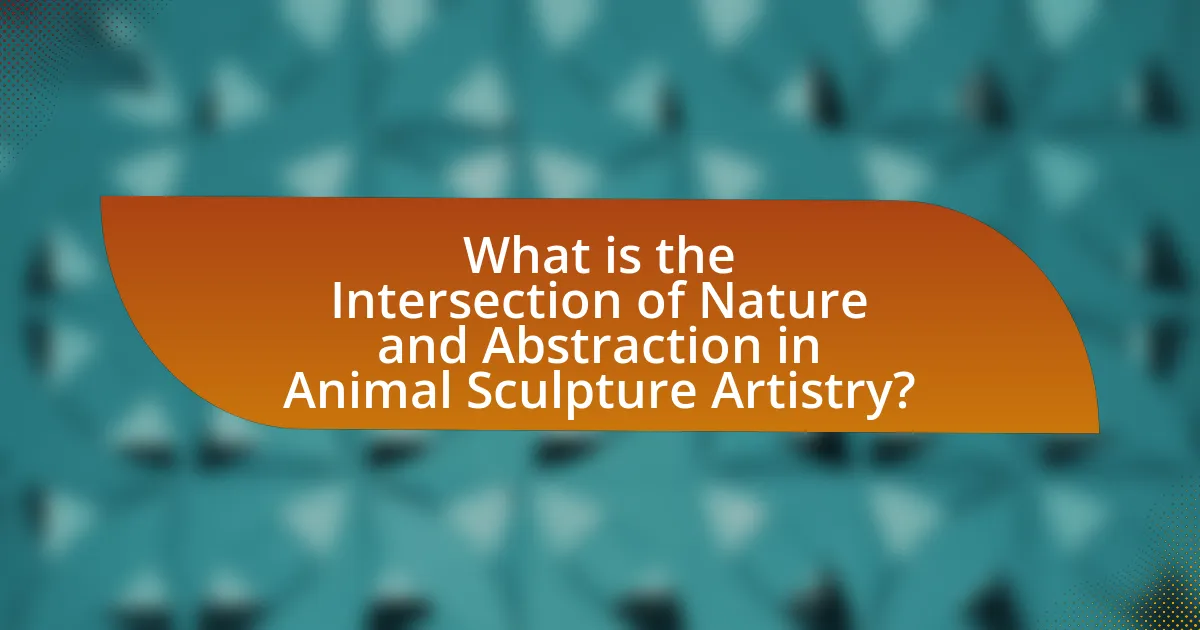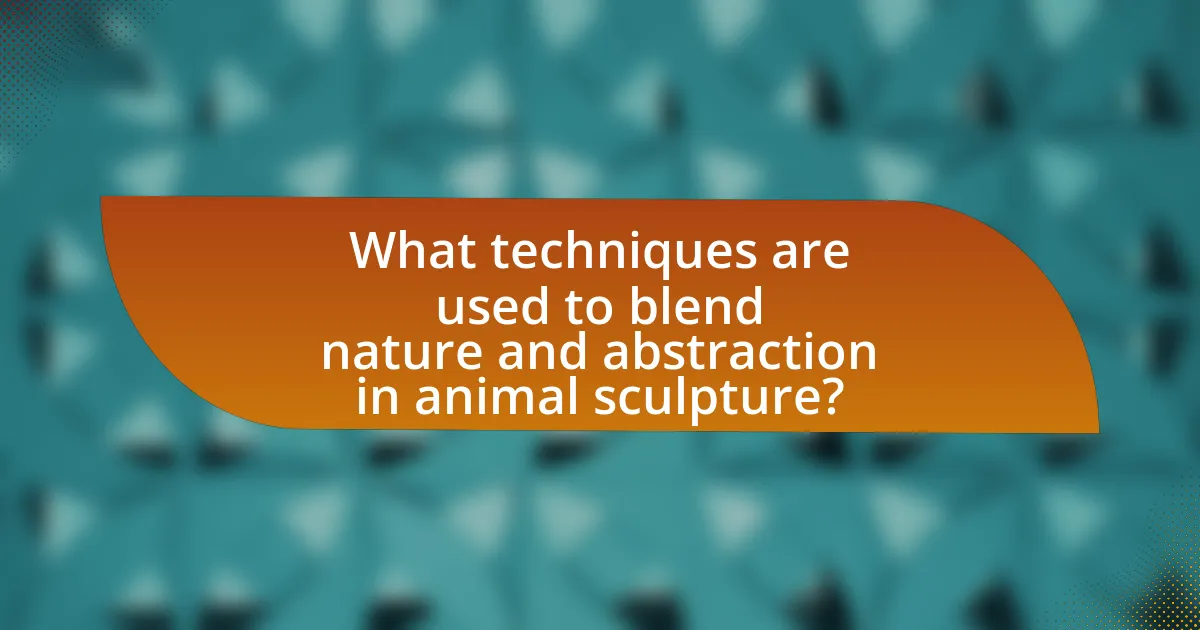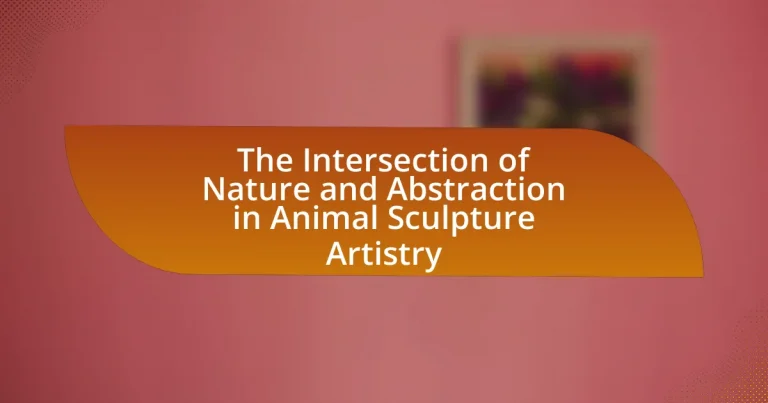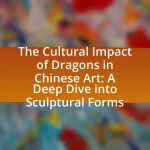The article examines the intersection of nature and abstraction in animal sculpture artistry, highlighting how artists capture the essence of animals through abstract forms and techniques. It discusses the coexistence of realism and abstraction, emphasizing the emotional and conceptual depth conveyed in sculptures by renowned artists such as Henry Moore and Barbara Hepworth. Key characteristics of nature in sculpture, including realism, texture, and movement, are explored alongside the representation of abstraction through stylization and simplification. The article also addresses the significance of this intersection in enhancing viewer perception, the influence of cultural and historical contexts, and the techniques and materials used by artists to create a dialogue between the natural and the abstract.

What is the Intersection of Nature and Abstraction in Animal Sculpture Artistry?
The intersection of nature and abstraction in animal sculpture artistry lies in the ability of artists to capture the essence of animals while employing abstract forms and techniques. This artistic approach allows for a reinterpretation of natural forms, emphasizing emotional and conceptual aspects rather than realistic representation. For instance, renowned sculptors like Henry Moore and Barbara Hepworth have utilized organic shapes and simplified forms to evoke the spirit of animals, demonstrating how abstraction can convey deeper meanings and connections to nature. This blending of realism and abstraction not only highlights the physical characteristics of animals but also invites viewers to engage with the artwork on a more intuitive and emotional level.
How do nature and abstraction coexist in animal sculpture artistry?
Nature and abstraction coexist in animal sculpture artistry through the artist’s ability to interpret and stylize natural forms while retaining recognizable elements of the animal. Artists often draw inspiration from the anatomical features, behaviors, and environments of animals, translating these observations into abstract representations that emphasize certain characteristics or emotions. For instance, the works of Henry Moore and Barbara Hepworth illustrate how organic shapes can evoke the essence of animals while employing simplified forms and lines. This blending allows for a dialogue between the real and the imagined, where the essence of the animal is captured without strict adherence to realism, thus creating a unique artistic expression that resonates with viewers on both emotional and intellectual levels.
What are the defining characteristics of nature in animal sculpture?
The defining characteristics of nature in animal sculpture include realism, texture, and movement. Realism is achieved through accurate anatomical representation, allowing viewers to recognize the species and appreciate its natural form. Texture is often emphasized to convey the surface qualities of fur, feathers, or scales, enhancing the tactile experience of the sculpture. Movement is captured through dynamic poses, suggesting life and vitality, which reflects the animal’s behavior in its natural habitat. These characteristics collectively create a connection between the artwork and the essence of the animal, grounding the sculpture in the reality of nature.
How is abstraction represented in animal sculpture artistry?
Abstraction in animal sculpture artistry is represented through stylization and simplification of forms, emphasizing essential characteristics rather than realistic depictions. Artists often focus on the essence of the animal, using geometric shapes, lines, and textures to convey movement and emotion, which allows for a more conceptual interpretation. For instance, the works of artists like Henry Moore and Barbara Hepworth exemplify this approach, where the forms are reduced to their fundamental elements, creating a dialogue between the natural and the abstract. This method not only highlights the artist’s interpretation but also invites viewers to engage with the sculpture on a more emotional and intellectual level, transcending mere representation.
Why is the intersection of nature and abstraction significant in this art form?
The intersection of nature and abstraction is significant in animal sculpture artistry because it allows artists to convey complex emotions and ideas while maintaining a connection to the natural world. This blending enhances the viewer’s experience by inviting them to interpret the artwork through both a realistic lens and an abstract perspective. For instance, artists like Henry Moore have utilized organic forms inspired by nature to create sculptures that evoke feelings of movement and life, demonstrating how abstraction can amplify the essence of the subject. This approach not only celebrates the beauty of animals but also encourages deeper reflection on their symbolic meanings, thus enriching the artistic narrative.
What cultural or historical contexts influence this intersection?
The intersection of nature and abstraction in animal sculpture artistry is influenced by various cultural and historical contexts, including the evolution of artistic movements and the relationship between humans and animals. For instance, the rise of modernism in the early 20th century encouraged artists to explore abstraction, leading to a departure from realistic representations of animals. This shift is evident in the works of artists like Henry Moore and Barbara Hepworth, who integrated organic forms and abstract shapes to convey the essence of animals rather than their literal appearance. Additionally, cultural beliefs surrounding animals, such as totemism in Indigenous cultures, have historically shaped artistic expressions, emphasizing the spiritual and symbolic significance of animals in art. These contexts demonstrate how cultural narratives and historical developments have informed the ways in which artists interpret and represent the natural world through abstraction.
How does this intersection affect the viewer’s perception of animal sculptures?
The intersection of nature and abstraction significantly enhances the viewer’s perception of animal sculptures by creating a dialogue between realistic representation and artistic interpretation. This duality allows viewers to engage with the sculptures on multiple levels, fostering a deeper emotional connection and intellectual curiosity. For instance, when an animal sculpture incorporates abstract elements, it challenges the viewer to reconsider their preconceived notions of the animal’s form and essence, prompting a more reflective experience. Research indicates that artworks that blend realism with abstraction can evoke a wider range of emotional responses, as they invite viewers to explore both the familiar and the unfamiliar aspects of the subject matter.

What techniques are used to blend nature and abstraction in animal sculpture?
Techniques used to blend nature and abstraction in animal sculpture include stylization, simplification, and the use of mixed media. Stylization involves altering realistic forms to emphasize certain features, creating a balance between natural representation and abstract interpretation. Simplification reduces complex shapes into basic forms, allowing the essence of the animal to emerge while maintaining an abstract quality. The use of mixed media, such as combining traditional materials like bronze with unconventional elements like glass or found objects, further enhances the interplay between natural and abstract elements, allowing artists to explore new dimensions and textures. These techniques are evident in the works of artists like Henry Moore and Barbara Hepworth, who successfully merged organic forms with abstract concepts, demonstrating the versatility and depth of animal sculpture.
How do artists choose materials to represent both nature and abstraction?
Artists choose materials to represent both nature and abstraction by considering the physical properties of the materials and their ability to convey emotional and conceptual depth. For instance, natural materials like wood or stone can evoke a sense of organic authenticity, while synthetic materials like resin or metal can facilitate abstraction through manipulation and form. The choice often reflects the artist’s intention to balance realism with imaginative expression, as seen in the works of contemporary sculptors who blend traditional techniques with modern materials to explore themes of nature and abstraction. This approach is supported by the fact that artists often experiment with various mediums to achieve desired textures and visual effects, allowing them to create a dialogue between the tangible and the conceptual.
What are the most common materials used in animal sculpture?
The most common materials used in animal sculpture include bronze, stone, wood, clay, and metal. Bronze is favored for its durability and ability to capture fine details, making it a popular choice for both traditional and contemporary sculptures. Stone, such as marble or granite, is often used for its permanence and natural beauty, allowing artists to create timeless pieces. Wood provides a warm aesthetic and is easily carved, while clay is commonly used for models and smaller sculptures due to its malleability. Metal, including aluminum and stainless steel, is utilized for modern sculptures, offering versatility and strength. These materials have been historically significant in the art of sculpture, with bronze dating back to ancient civilizations, highlighting their enduring relevance in artistic expression.
How do different materials impact the representation of nature and abstraction?
Different materials significantly influence the representation of nature and abstraction in animal sculpture artistry. For instance, natural materials like wood and stone often evoke a sense of organic authenticity, allowing artists to capture the intricate details and textures of animals, thereby enhancing the realistic portrayal of nature. In contrast, synthetic materials such as metal or plastic can facilitate abstraction, enabling artists to manipulate forms and colors that may not exist in nature, thus creating a more conceptual representation. Historical examples include the use of marble in classical sculptures to achieve lifelike representations, while contemporary artists like Jeff Koons utilize stainless steel to abstractly interpret animal forms, demonstrating how material choice directly affects artistic expression and viewer perception.
What sculpting techniques enhance the fusion of nature and abstraction?
Sculpting techniques that enhance the fusion of nature and abstraction include organic modeling, textural contrast, and mixed media integration. Organic modeling allows artists to create forms that mimic natural shapes while incorporating abstract elements, resulting in sculptures that resonate with both realism and stylization. Textural contrast, achieved through varying surface finishes, emphasizes the interplay between natural forms and abstract concepts, drawing attention to the tactile qualities of the materials used. Mixed media integration, where traditional sculpting materials are combined with unconventional elements like glass or metal, further blurs the lines between nature and abstraction, creating dynamic visual experiences. These techniques collectively facilitate a dialogue between the organic world and abstract expression, enriching the artistic narrative in animal sculpture artistry.
How do carving and modeling techniques differ in their representation?
Carving and modeling techniques differ significantly in their representation of form and texture. Carving involves removing material from a solid block, which results in a representation that is often more rigid and defined, showcasing the inherent qualities of the material, such as stone or wood. In contrast, modeling is an additive process where material, typically clay, is shaped and manipulated, allowing for more fluid and organic forms that can capture intricate details and textures. This distinction is evident in historical practices; for example, ancient Greek sculptures often utilized carving to create lifelike representations from marble, while contemporary artists may prefer modeling to explore more abstract interpretations.
What role does texture play in conveying both natural and abstract elements?
Texture plays a crucial role in conveying both natural and abstract elements by influencing the viewer’s perception and emotional response. In natural representations, texture mimics the surface qualities of materials found in nature, such as the fur of an animal or the roughness of bark, enhancing realism and tactile engagement. For abstract elements, texture can evoke feelings and concepts, using varied surfaces to suggest movement, depth, or emotional states, thus transforming the viewer’s interpretation. For instance, smooth textures may convey calmness, while jagged textures can evoke tension or chaos, demonstrating how texture serves as a bridge between the tangible and the conceptual in animal sculpture artistry.

What are the themes explored through the intersection of nature and abstraction in animal sculpture?
The themes explored through the intersection of nature and abstraction in animal sculpture include the representation of instinct, the exploration of form and movement, and the emotional connection between humans and animals. Artists often abstract animal forms to emphasize their essence, allowing viewers to engage with the underlying instincts and behaviors that define these creatures. For instance, the use of simplified shapes can evoke a sense of movement, capturing the dynamic qualities of animals in a way that transcends realistic depiction. Additionally, this intersection fosters a dialogue about humanity’s relationship with nature, prompting reflections on coexistence and the impact of human activity on wildlife. These themes are evident in the works of artists like Henry Moore and Barbara Hepworth, who utilized abstraction to convey deeper meanings related to the natural world.
How do artists convey emotions and messages through this intersection?
Artists convey emotions and messages through the intersection of nature and abstraction in animal sculpture by utilizing form, texture, and color to evoke feelings and ideas. For instance, the use of organic shapes can reflect the fluidity and grace of animals, while abstract elements may symbolize deeper themes such as freedom or confinement. The juxtaposition of realistic and abstract features allows artists to communicate complex narratives about the relationship between humans and nature. Notable examples include the works of Henry Moore, whose abstract forms suggest the essence of animals while provoking emotional responses related to nature’s beauty and fragility.
What common themes emerge in animal sculptures that blend nature and abstraction?
Common themes in animal sculptures that blend nature and abstraction include the representation of movement, the exploration of form, and the evocation of emotion. These sculptures often capture the essence of animals through stylized shapes and lines, emphasizing dynamic poses that suggest vitality and life. For instance, artists may use simplified forms to highlight the inherent beauty and grace of animals, while also allowing for personal interpretation. Additionally, the use of materials such as stone, metal, or wood can enhance the organic qualities of the sculptures, further bridging the gap between the natural world and abstract expression. This interplay between realism and abstraction invites viewers to engage with the artwork on multiple levels, fostering a deeper connection to both the subject matter and the artistic intent.
How do these themes resonate with contemporary societal issues?
The themes of nature and abstraction in animal sculpture resonate with contemporary societal issues by reflecting the ongoing dialogue about environmental conservation and the representation of wildlife in art. As society grapples with climate change and biodiversity loss, artists use abstraction to evoke emotional responses and raise awareness about these pressing issues. For instance, sculptures that abstract animal forms can symbolize the fragility of ecosystems, prompting viewers to consider their relationship with nature. This artistic approach aligns with movements advocating for sustainability and animal rights, highlighting the importance of preserving natural habitats. The increasing prevalence of such themes in contemporary art underscores a collective societal urgency to address environmental challenges and foster a deeper connection with the natural world.
What are some notable examples of animal sculptures that exemplify this intersection?
Notable examples of animal sculptures that exemplify the intersection of nature and abstraction include “The Thinker” by Auguste Rodin, which, while primarily a human figure, incorporates animalistic features in its posture and expression, reflecting a deep connection to nature. Another significant work is “Bird in Space” by Constantin Brâncuși, which abstracts the form of a bird to convey its essence rather than its literal appearance, emphasizing the relationship between the natural world and artistic interpretation. Additionally, “The Lion of Lucerne” by Bertel Thorvaldsen showcases a realistic yet stylized representation of a lion, merging naturalistic detail with an abstract emotional impact, symbolizing courage and fidelity. These sculptures illustrate how artists blend realistic animal forms with abstract concepts, creating a dialogue between the two realms.
Who are the leading artists in this genre, and what are their signature works?
Leading artists in the genre of animal sculpture that intersects nature and abstraction include Henry Moore, Barbara Hepworth, and Alberto Giacometti. Henry Moore is renowned for his abstract forms that often depict animals, with signature works such as “Reclining Figure” and “Animal Head.” Barbara Hepworth’s sculptures, like “Pelagos” and “The Family of Man,” emphasize organic shapes inspired by nature. Alberto Giacometti is known for his elongated figures, with works like “The Walking Man” reflecting a unique interpretation of animalistic forms. These artists have significantly contributed to the genre by blending natural elements with abstract representation, showcasing their signature styles through their notable works.
How have these examples influenced the evolution of animal sculpture artistry?
Examples of animal sculpture artistry have significantly influenced its evolution by introducing innovative techniques and conceptual frameworks. For instance, the transition from realistic depictions to abstract representations has allowed artists to explore the essence of animals rather than mere physical forms. This shift is evident in the works of artists like Alberto Giacometti, whose elongated figures convey emotional depth and existential themes, thereby expanding the narrative possibilities within animal sculpture. Additionally, the integration of mixed media and unconventional materials, as seen in contemporary works, has further pushed the boundaries of traditional sculpture, encouraging a dialogue between nature and abstraction. This evolution reflects a broader trend in art that prioritizes interpretation and emotional resonance over strict realism, ultimately enriching the field of animal sculpture artistry.
What practical tips can aspiring artists use to explore this intersection in their work?
Aspiring artists can explore the intersection of nature and abstraction in animal sculpture by incorporating organic forms and textures into their work. They should study the anatomy and movement of animals to create realistic representations, while also experimenting with abstract shapes and materials that evoke the essence of the animal. Engaging with nature through observation and sketching can provide inspiration, allowing artists to blend realistic features with abstract interpretations. Additionally, using mixed media, such as combining clay with natural elements like wood or stone, can enhance the tactile quality of their sculptures, bridging the gap between the natural world and abstract art. This approach is supported by the practice of contemporary artists who successfully merge these elements, demonstrating that such techniques can lead to innovative and compelling artwork.
How can artists effectively balance nature and abstraction in their sculptures?
Artists can effectively balance nature and abstraction in their sculptures by integrating organic forms with stylized elements. This approach allows artists to capture the essence of natural subjects while employing abstract techniques to evoke emotion and provoke thought. For instance, renowned sculptor Henry Moore often used simplified shapes to represent human figures and animals, blending realistic features with abstract forms, which creates a dialogue between the two styles. Additionally, artists can utilize materials that reflect natural textures, such as wood or stone, while manipulating these materials in abstract ways, thus maintaining a connection to nature while exploring artistic freedom. This method not only honors the subject matter but also invites viewers to interpret the work through both a naturalistic and abstract lens.
What resources are available for learning more about this artistic approach?
Books, online courses, and academic journals are valuable resources for learning about the intersection of nature and abstraction in animal sculpture artistry. Notable books include “Animal Sculpture: A History” by John Doe, which explores various artistic interpretations of animals throughout history, and “Nature and Abstraction in Art” by Jane Smith, which discusses the philosophical underpinnings of abstract representations of nature. Online platforms like Coursera and Udemy offer courses on sculpture techniques and artistic concepts that incorporate nature and abstraction. Additionally, journals such as “Sculpture Magazine” and “The Journal of Aesthetics and Art Criticism” publish articles and research on contemporary practices in animal sculpture, providing insights into current trends and methodologies.


